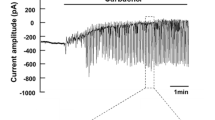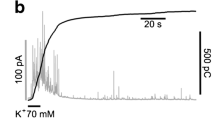Abstract
Double-barrelled, chloride-selective microelectrodes were used to study mandibular gland acinar cells at rest and during cholinergic stimulation. At rest, intracellular chloride activity was five times the expected equilibrium activity. During sustained stimulation with acetylcholine, chloride activity fell to three times the expected equilibrium activity. Thus, the gradient for chloride exit was reduced in the stimulated cell. These results lead to the conclusion that stimulation increases the permeability of the acinar cell to chloride. Experiments in which extracellular chloride was removed provided evidence that the permeability increase was due to opening of chloride channels located principally in the apical membrane of the acinar cell.
Similar content being viewed by others
References
Ansah TA, Wilson L, Case RM (1988) Cytosolic free calcium in rabbit mandibular salivary gland cells following cholinergic stimulation. In: Davison JS (ed) Gastrointestinal secretion. Calgary University Press, Calgary (in press)
Bates RG, Staples BR, Robinson RA (1970) Ionic hydration and single ion activities in unassociated chlorides at high ionic strengths. Anal Chem 42:867–871
Bijman J, Cook DI, van Os CH (1983) Effect of amiloride on electrolyte transport parameters of the main duct of the rabbit mandibular salivary gland. Pflügers Arch 398:96–102
Butcher FR, Putney JW (1981) Regulation of parotid gland function by cyclic nucleotides. Adv Cyclic Nucleotide Protein Phosphorylation Res 13:215–249
Case RM, Conigrave AD, Novak I, Young JA (1980) Electrolyte and protein secretion by the perfused rabbit mandibular gland stimulated with acetylcholine or catecholamines. J Physiol 300:467–487
Case RM, Hunter M, Novak I, Young JA (1984) The anionic basic of fluid secretion by the rabbit mandibular salivary gland. J Physiol 349:619–630
Case RM, Howorth AJ, Lau KR (1986) The effects of bumetanide on the stimulated rabbit mandibular salivary gland. J Physiol 378:103P
Christoffersen GRJ, Skibsted LH (1975) Calcium ion activity in physiological salt solutions: influence of anions substituted for chloride. Comp Biochem Physiol 52A:317–322
Findlay I, Petersen OH (1985) Acetylcholine stimulates a Ca2+-dependent Cl− conductance in mouse lacrimal acinar cells. Pflügers Arch 403:328–330
Fromm M, Schultz SG (1981) Some properties of KCl-filled microelectrodes: correlation of potassium “leakage” with tip resistance. J Membr Biol 62:239–244
Frömter E, Gebler B, Schopow K, Pockrandt-Hemstedt J (1974) Cation and anion permeability of rabbit submaxillary main duct. In: Thorn NA, Petersen OH (eds) Secretory mechanisms of exocrine glands. Munksgaard Copenhagen pp 469–513
Greger R, Schlatter E, Wang F, Forrest JN (1984) Mechanism of NaCl secretion in rectal gland tubules of spiny dogfish (Squalus acanthias). III. Effect of stimulation of secretion by cyclic AMP. Pflügers Arch 402:376–384
Hodgkin AL, Katz B (1949) The effect of sodium ions on the electrical activity of the giant axon of the giant squid. J Physiol 108:37–77
Hunter M, Smith PA, Case RM (1983) The dependence of fluid secretion by mandibular salivary gland and pancreas on extracellular calcium. Cell Calcium 4:307–317
Mangos JA, McSherry NR, Irwin K, Hong R (1973) Handling of water and electrolytes by rabbit parotid and submaxillary gland. Am J Physiol225:450–455
Martinez JR, Cassity N (1985) Effects of 4,4′-diisothiocyano-2,2′-stilbene disulphonic acid and amiloride on salivary secretion by isolated, perfused rat submandibular glands. Arch Oral Biol 30:797–803
Marty A, Tan YP, Trautmann A (1984) Three types of calcium-dependent channel in rat lacrimal glands. J Physiol 357:293–325
Murakami M, Novak I, Young JA (1986) Choline evokes fluid secretion by perfused rat mandibular gland without desensitization. Am J Physiol 251:G81-G89
Nishiyama A, Petersen OH (1974) Membrane potential and resistance measurement in acinar cells from salivary glands in vitro: effect of acetylcholine. J Physiol 242:173–188
Novak I, Young JA (1986) Two independent anion transport systems in rabbit mandibular salivary glands. Pflügers Arch 407:649–656
Petersen OH (1986) Calcium-activated potassium channels and fluid secretion by exocrine glands. Am J Physiol 251:G1-G13
Reuss L, Reinach P, Weinman SA, Grady TP (1983) Intracellular ion activities and Cl− transport mechanisms in bullforg corneal epithelium. Am J Physiol 244:C336-C347
Saito Y, Ozawa T, Hayashi H, Nishiyama A (1987) The effect of acetylcholine on chloride transport across the mouse lacrimal gland acinar cell membranes. Pflügers Arch 409:280–288
Thaysen JH, Thorn NA, Schwartz IL (1954) Excretion of sodium, potassium, chloride and carbon dioxide in human parotid saliva. Am J Physiol 178:155–159
Wakui M, Nishiyama A (1980) Ionic dependence of acetylcholine equilibrium potential of acinar cells in mouse submaxillary gland. Pflügers Arch 386:261–267
Welsh MJ, Smith PL, Frizzell RA (1983) Chloride secretion by canine tracheal epithelium. III. Membrane resistances and electromotive forces. J Membr Biol 71:209–218
Young JA, Martin CJ (1971) The effect of a sympatho-and a parasympathomimetic drug on the electrolyte concentrations of primary and final saliva of the rat submaxillary gland. Pflügers Arch 327:285–302
Zeuthen T, Hiam RC, Silver IA (1973) Microelectrode recording of ion activity in brains. In: Berman HJ, Hebert NC (eds) Ion selective microelectrodes Plenum Press New York, pp 145–156
Author information
Authors and Affiliations
Rights and permissions
About this article
Cite this article
Lau, K.R., Case, R.M. Evidence for apical chloride channels in rabbit mandibular salivary glands. Pflugers Arch. 411, 670–675 (1988). https://doi.org/10.1007/BF00580864
Received:
Revised:
Accepted:
Issue Date:
DOI: https://doi.org/10.1007/BF00580864




